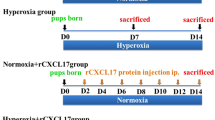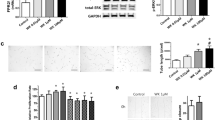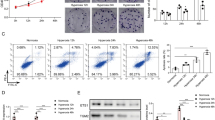Abstract
Transforming growth factor-β (TGF-β) superfamily members are key regulators for lung development and progress of bronchopulmonary dysplasia (BPD). The mechanisms by which lipoxin A4 (LXA4) attenuates development of BPD have not been clarified. Neonatal murine BPD models were inducted by hyperoxia treatment. Neonatal mice were exposed to room air or 85% O2 hyperoxia with or without treatment with 5S,6R-methyl-LXA4 or anti-TGF-β antibodies. Mouse lung epithelial cells (MLE-12 cells) and mouse embryonic fibroblasts (NIH/3T3 cells) were cultured in room air or 85% O2 followed by treatment of LXA4, anti-TGF-β antibodies, and let-7c mimic/anti-microRNA transfections. Treatment with 5S,6R-methyl-LXA4 and anti-TGF-β antibodies both attenuated the mice alveolar simplification induced by hyperoxia. Hyperoxia treatment significantly altered pulmonary basal mRNA and protein expressions of several important extracellular matrix (ECM) and ECM remodeling proteins including fibronectin, α-smooth muscle actin (α-SMA), tissue inhibitor of metalloproteinase-1 (TIMP-1), elastin, tenascin C, collagen I, and matrix metalloproteinase-1 (MMP-1). 5S,6R-methyl-LXA4 and anti-TGF-β antibodies suppressed the mRNA and protein expressions of TGF-β1 and TGF-βR1 but not TGF-βR2 in the lungs exposed to hyperoxia. Treatment with LXA4 and anti-TGF-β antibodies alleviated hyperoxia-induced injury of the NIH/3T3 cells identified by morphologic observation and flow cytometry, and expressions of ECM, ECM remodeling proteins, and TGF-β1 signaling pathway, but reversed by transfection with let-7c anti-miRNA. LXA4 upregulated the let-7c expression in MLE-12 cells, transfection with let-7c anti-miRNA, inhibited the LXA4-induced let-7c expression in MLE-12 cells exposed to hyperoxia and reduced the relative luciferase activity of let-7c binding with let-7c binding sites of the TGF-βR1 3′ UTR. Treatment with 5S,6R-methyl-LXA4 and anti-TGF-β antibodies significantly improved histology, ECM, and ECM remodeling proteins in the lungs isolated from the murine BPD model induced by hyperoxia. The LXA4-imparted protective effects on hyperoxia-induced lung injury are mediated by upregulation of let-7c and inhibition of TGF-β1 and subsequent downregulation of TGF-β1 signaling pathway.









Similar content being viewed by others
References
Thébaud, B., and S.H. Abman. 2007. Bronchopulmonary dysplasia: where have all the vessels gone? Roles of angiogenic growth factors in chronic lung disease. American Journal of Respiratory and Critical Care Medicine 175 (10): 978–985.
Stoll, B.J., N.I. Hansen, E.F. Bell, et al. 2015. Trends in care practices, morbidity, and mortality of extremely preterm neonates, 1993-2012. Journal of the American Medical Association 314: 1039–1051.
Eichenwald, E.C., and A.R. Stark. 2008. Management and outcomes of very low birth weight. The New England Journal of Medicine 358: 1700–1711.
Stenmark, K.R., and S.H. Abman. 2015. Lung vascular development: implications for the pathogenesis of bronchopulmonary dysplasia. Annual Review of Physiology 67: 623–661.
Bhandari, V. 2010. Hyperoxia-derived lung damage in preterm infants. Seminars in Fetal & Neonatal Medicine 15 (4): 223–229.
Alejandre-Alcázar, M.A., G. Kwapiszewska, I. Reiss, O.V. Amarie, L.M. Marsh, J. Sevilla-Pérez, M. Wygrecka, B. Eul, S. Köbrich, M. Hesse, R.T. Schermuly, W. Seeger, O. Eickelberg, and R.E. Morty. 2007. Hyperoxia modulates TGF-β/BMP signaling in a mouse model of bronchopulmonary dysplasia. American Journal of Physiology. Lung Cellular and Molecular Physiology 292 (2): L537–L549.
Dasgupta, C., R. Sakurai, Y. Wang, P. Guo, N. Ambalavanan, J.S. Torday, and V.K. Rehan. 2009. Hyperoxia-induced neonatal rat lung injury involves activation of TGF-β and Wnt signaling and is protected by rosiglitazone. American Journal of Physiology. Lung Cellular and Molecular Physiology 296 (6): L1031–L1041.
Roth-Kleiner, M., and M. Post. 2015. Similarities and dissimilarities of branching and septation during lung development. Pediatric Pulmonology 40: 113–134.
Ahlfeld, S.K., J. Wang, Y. Gao, P. Snider, and S.J. Conway. 2016. Initial suppression of transforming growth factor-β signaling and loss of TGFβ1 causes early alveolar structural defects resulting in bronchopulmonary dysplasia. The American Journal of Pathology 13. doi:10.1016/j. ajpath.2015.11.024.
Yang, Y., G. Kai, X.D. Pu, K. Qing, X.R. Guo, and X.Y. Zhou. 2012. Expression profile of microRNAs in fetal lung development of Sprague-Dawley rats. International Journal of Molecular Medicine 29 (3): 393–402.
Mondol, V., and A.E. Pasquinelli. 2012. Let’s make it happen: the role of let-7 microRNA in development. Current Topics in Developmental Biology 99: 1–30.
Yang, Y., J. Qiu, Q. Kan, X.G. Zhou, and X.Y. Zhou. 2013. MicroRNA expression profiling studies on bronchopulmonary dysplasia: a systematic review and meta-analysis. Genetics and Molecular Research 12 (4): 5195–5206.
Pandit, K.V., D. Corcoran, H. Yousef, M. Yarlagadda, A. Tzouvelekis, K.F. Gibson, K. Konishi, S.A. Yousem, M. Singh, D. Handley, T. Richards, M. Selman, S.C. Watkins, A. Pardo, A. Ben-Yehudah, D. Bouros, O. Eickelberg, P. Ray, P.V. Benos, and N. Kaminski. 2010. Inhibition and role of let-7d in idiopathic pulmonary fibrosis. American Journal of Respiratory and Critical Care Medicine 182 (2): 220–229.
Pandit, K.V., J. Milosevic, and N. Kaminski. 2011. MicroRNAs in idiopathic pulmonary fibrosis. Translational Research 157 (4): 191–199.
Pandit, K.V., and J. Milosevic. 2015. MicroRNA regulatory networks in idiopathic pulmonary fibrosis. Biochemistry and Cell Biology 93 (2): 129–137.
Martin, C.R., D.A. Dasilva, J.E. Cluette-Brown, C. Dimonda, A. Hamill, A.Q. Bhutta, E. Coronel, M. Wilschanski, A.J. Stephens, D.F. Driscoll, B.R. Bistrian, J.H. Ware, M.M. Zaman, and S.D. Freedman. 2011. Decreased postnatal docosahexaenoic and arachidonic acid blood levels in premature infants are associated with neonatal morbidities. The Journal of Pediatrics 159 (5): 743–749.
Romano, M., E. Cianci, F. Simiele, and A. Recchiuti. 2015. Lipoxins and aspirin-triggered lipoxins in resolution of inflammation. European Journal of Pharmacology 760: 49–63.
Jin, S.W., L. Zhang, Q.Q. Lian, D. Liu, P. Wu, S.L. Yao, and D.Y. Ye. 2007. Posttreatment with aspirin-triggered lipoxin A4 analog attenuates lipopolysaccharide-induced acute lung injury in mice: the role of heme oxygenase-1. Anesthesia and Analgesia 104: 369–377.
Martin, C.R., M.M. Zaman, C. Gilkey, M.V. Salguero, H. Hasturk, A. Kantarci, T.E. Van Dyke, and S.D. Freedman. 2014. Resolvin D1 and lipoxin A4 improve alveolarization and normalize septal wall thickness in a neonatal murine model of hyperoxia-induced lung injury. PloS One 9 (6): e98773.
Chen, X.Q., S.H. Wu, Y. Zhou, and Y.R. Tang. 2013. Lipoxin A4-induced heme oxygenase-1 protects cardiomyocytes against hypoxia/reoxygenation injury via p38 MAPK activation and Nrf2/ARE complex. PloS One 8: e67120.
Wright, C.J., and H. Kirpalani. 2011. Targeting inflammation to prevent bronchopulmonary dysplasia: can new insights be translated into therapies? Pediatrics 128: 111–126.
Nakanishi, H., T. Sugiura, J.B. Streisand, S.M. Lonning, and J.D. Roberts. 2007. TGF-β-neutralizing antibodies improve pulmonary alveologenesis and vasculogenesis in the injured newborn lung. American Journal of Physiology. Lung Cellular and Molecular Physiology 293: L151–L161.
Rodgers, K., B. McMahon, D. Mitchell, D. Sadlier, and C. Godson. 2005. Lipoxin A4 modifies platelet-derived growth factor-induced profibrotic gene expression in human renal mesangial cells. The American Journal of Pathology 167 (3): 683–694.
Brennan, E.P., K.A. Nolan, E. Börgeson, O.S. Gough, C.M. McEvoy, N.G. Docherty, D.F. Higgins, M. Murphy, D.M. Sadlier, S.T. Ali-Shah, P.J. Guiry, D.A. Savage, A.P. Maxwell, F. Martin, and C. Godson. 2013. Lipoxins attenuate renal fibrosis by inducing let-7c and suppressing TGFβR1. Journal of the American Society of Nephrology 24: 627–637.
Börgeson, E., N.G. Docherty, M. Murphy, K. Rodgers, A. Ryan, T.P. O'Sullivan, P.J. Guiry, R. Goldschmeding, D.F. Higgins, and C. Godson. 2011. Lipoxin A4 and benzo-lipoxin A4 attenuate experimental renal fibrosis. The FASEB Journal 25 (9): 2967–2979.
Acknowledgements
This work was supported by the National Natural Scientific Grand (No. 81300521) from the Government of China and by the Priority Academic Program Development (PAPD) of Jiangsu Higher Education Institutions (JX10231801).
Author information
Authors and Affiliations
Corresponding author
Ethics declarations
Funding
This work was supported by National Natural Scientific Grand (No. 81300521 and No. 81370746) from the Government of China and by the Priority Academic Program Development (PAPD) of Jiangsu Higher Education Institutions (JX10231801).
The funders had no role in study design, data collection and analysis, decision to publish, or preparation of the manuscript.
Conflict of Interest
The authors declare that they have no competing interests.
Rights and permissions
About this article
Cite this article
Chen, XQ., Wu, SH., Luo, YY. et al. Lipoxin A4 Attenuates Bronchopulmonary Dysplasia via Upregulation of Let-7c and Downregulation of TGF-β1 Signaling Pathway. Inflammation 40, 2094–2108 (2017). https://doi.org/10.1007/s10753-017-0649-7
Published:
Issue Date:
DOI: https://doi.org/10.1007/s10753-017-0649-7




